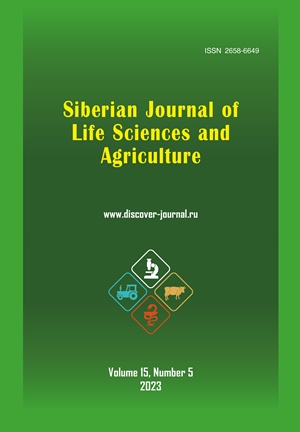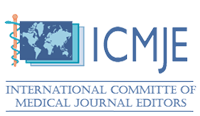СРАВНИТЕЛЬНЫЙ МОРФОМЕТРИЧЕСКИЙ АНАЛИЗ РАЗЛИЧНЫХ ГРУПП – «ОПТИМАЛЬНЫХ» И «НЕОПТИМАЛЬНЫХ» ДИХОТОМИЙ ВНУТРИОРГАННОГО АРТЕРИАЛЬНОГО РУСЛА СЕЛЕЗЕНКИ ЧЕЛОВЕКА
Аннотация
Обоснование. Применение малоинвазивной хирургии требует детального знания об особенностях внутриорганного артериального русла селезенки. Перспективным направлением такого анализа является количественное исследование внутриорганного сосудистого русла паренхиматозных органов как фрактальной или квазифрактальной системы.
Цель работы: установить морфометрические особенности разных групп дихотомий («оптимальные»/«неоптимальные») внутриорганного артериального русла селезенки у лиц разного пола и возраста.
Материалы и методы. На коррозионных препаратах внутриорганного артериального русла селезенки (ВАРС) (67-ти людей, 1-го и 2-го периода зрелого возраста, обоего пола) были исследованы морфометрические особенности «оптимальных» и «неоптимальных» дихотомий (критерии оптимальности C.D. Murray и H. B. M. Ulings).
Результаты. Установлено, что «оптимальные» дихотомии в соответствии с критерием Murray C. D. составляли 1%, а в соответствии с критерием Ulings H. B. M. «оптимальные» дихотомии составляли 9% общего количества исследованных дихотомий коррозионных препаратов ВАРС. Относительное количество «оптимальных» дихотомий в составе ВАРС лиц мужского пола несколько больше, чем у женщин. Относительное количество «оптимальных» дихотомий в составе ВАРС лиц 1-го периода зрелого возраста меньше, чем у лиц 2-го периода зрелого возраста. «Оптимальные» дихотомии располагаются, в основном, на проксимальных генерациях и уровнях деления ВАРС, имеют большие размеры и являются менее симметричными по сравнению с «неоптимальными» дихотомиями.
Заключение. Величины морфометрических показателей разных групп дихотомий ВАРС представителей разного пола, а также лиц 1-го и 2-го периода зрелого возраста значимо отличаются, что следует учитывать при численном моделировании структуры ВАРС.
Скачивания
Литература
Список литературы
Автандилов Г.Г. Основы количественной патологической анатомии : Учебное пособие / Г.Г. Автандилов. М.: Медицина, 2002. 240 с.
Аналитическая и трехмерная (3D) анатомия сосудистого русла почки человека : монография / О.К. Зенин [и др.]. Грозный: Изд-во Чеченского гос. ун-та, 2021. 218 с.
Ахмедов В.А. Современные взгляды на факторы возникновения и прогрессирования атеросклероза / В.А. Ахмедов, А.С. Шевченко, А.С. Исаева // РМЖ. Медицинское обозрение. 2019. Т. 3. № 1. С. 57-62.
Глотов В.А. Структурный анализ микрососудистых бифуркаций (микрососудистый узел и гемодинамический фактор) / В.А. Глотов. Смоленск: Ампипресс, 1995. 251 с.
Зенин О.К. Морфометрическая характеристика артериального русла головного мозга человека в соответствии с дихотомической моделью его строения / О.К. Зенин, А.В. Дмитриев, Ю.В. Довгялло // Известия высших учебных заведений. Поволжский регион. Медицинские науки. 2019. № 4 (52). С. 111-118.
Зенин О.К. Морфометрический анализ применимости уравнений Murray C.D. для численного моделирования сосудистых дихотомий почки человека / О.К. Зенин, И.С. Милтых, А.В. Дмитриев // Siberian Journal of Life Science and Agriculture. 2022. Т. 13. № 3. С. 170-192. https://doi.org/10.12731/2658-6649-2021-13-3-170-192
Комиссарова Е.Н. Морфологические критерии возрастной гигиены / Е.Н. Комиссарова, П.В. Родичкин, Л.А. Сазанова. СПб, 2014. 64 с.
Ляпунов А.А. Проблемы теоретической и прикладной кибернетики / А.А. Ляпунов Citation Key: 1980. М.: Наука, 1980.
Мамисашвили В.А. Критерий оптимального функционирования подсистем крупных и мелких пиальных артерий / В.А. Мамисашвили, М.К. Бабунашвили // Физиологический журнал СССР. 1975. Т. 61. № 10. С. 1501-1506.
Основы компьютерной биостатистики: анализ информации в биологии, медицине и фармации статистическим пакетом MedStat / Ю.Е. Лях [и др.]. Донецк: Папакица Е. К., 2006. 214 с.
Реброва О.Ю. Описание статистического анализа данных в оригинальных статьях. Типичные ошибки / О.Ю. Реброва // Флебология. 2011. № 3. С. 74-77.
Розен Р. Принцип оптимальности в биологии / Р. Розен. М.: Мир, 1969. 215 с.
Черноусько Ф.Л. Некоторые оптимальные конфигурации ветвящихся стержней / Ф.Л. Черноусько // Изв. АН СССР. МТТ. 1979. № 3. С. 174-181.
Balcı S. ClinicoPath Jamovi Module / S. Balcı. 2022. https://doi.org/10.17605/OSF.IO/9SZUD
Cooper M.J. Splenectomy: Indications, hazards and alternatives / M.J. Cooper, R.C.N. Williamson // British Journal of Surgery. 2005. Vol. 71. Splenectomy. № 3. P. 173-180. https://doi.org/10.1002/bjs.1800710302
Dmitriev A. Conceptional models of the tree-shape arterial bed / A. Dmitriev, Yu. Dovgiallo, O. Zenin // Scripta scientifica medica. 2008. Vol. 40. P. 23.
Dokoumetzidis A. A model for transport and dispersion in the circulatory system based on the vascular fractal tree / A. Dokoumetzidis, P. Macheras // Ann. Biomed Eng. 2003. Vol. 31. № 3. P. 284-293.
Explanatory report on the European Convention for the Protection of Vertebrate Animals Used for Experimental and Other Scientific Purposes / ed. Council of Europe. Strasbourg : Croton, N.Y: The Council ; Manhattan Pub. Co. [distributor], 1986. 75 p.
Fractal Properties of Perfusion Heterogeneity in Optimized Arterial Trees / R. Karch [et al.] // The Journal of General Physiology. 2003. Vol. 122. № 3. P. 307-322. https://doi.org/10.1085/jgp.200208747
Gray’s Anatomy: The Anatomical Basis of Clinical Practice / ed. S. Standring. 42. London: Elsevier, 2021. 1606 p.
Kajiya F. Cardiac Hemodynamics, Coronary Circulation and Interventional Cardiology / F. Kajiya, M. Zamir, S. Carlier // Annals of Biomedical Engineering. 2005. Vol. 33. № 12. P. 1728-1734. https://doi.org/10.1007/s10439-005-8777-x
Kalpana R. A Study On Principal Branches of Coronary Arteries In Humans / R. Kalpana // Journal of the Anatomical Society of India. 2003. Vol. 52. № 2.
Kamiya A. Theoretical relationship between the optimal models of the vascular tree / A. Kamiya, T. Togawa, A. Yamamoto // Bulletin of Mathematical Biology. 1974. Vol. 36. № 3. P. 311-323.
Kassab G.S. Functional hierarchy of coronary circulation: direct evidence of a structure-function relation / G.S. Kassab // American Journal of Physiology-Heart and Circulatory Physiology. 2005. Vol. 289. № 6. P. H2559-H2565. https://doi.org/10.1152/ajpheart.00561.2005
Kehila M. [Partial splenectomy requiring ligation of splenic vessels. Apropos of 40 cases] / M. Kehila, T. Abderrahim // Annales De Chirurgie. 1993. Vol. 47. № 5. P. 433-435.
Kizilova N. Computational Approach to Optimal Transport Network Construction in Biomechanics / N. Kizilova // Computational Science and Its Applications – ICCSA 2004 / coll. T. Kanade [et al.]; eds. A. Laganá [et al.]. Berlin, Heidelberg: Springer Berlin Heidelberg, 2004. Vol. 3044. P. 476-485.
Marxen M. Branching tree model with fractal vascular resistance explains fractal perfusion heterogeneity / M. Marxen, R.M. Henkelman // American Journal of Physiology-Heart and Circulatory Physiology. 2003. Vol. 284. № 5. P. H1848-H1857. https://doi.org/10.1152/ajpheart.00510.2002
Murray C.D. The physiological principle of minimum work applied to the angle of branching of arteries / C.D. Murray // Journal of General Physiology. 1926. Vol. 9. № 6. P. 835-841. https://doi.org/10/dq9qn9
Nerem R.M. Role of mechanics in vascular tissue engineering / R.M. Nerem // Biorheology. 2003. Vol. 40. № 1-3. P. 281-287.
Numerical Simulation and Experimental Validation of Blood Flow in Arteries with Structured-Tree Outflow Conditions / M.S. Olufsen [et al.] // Annals of Biomedical Engineering. 2000. Vol. 28. № 11. P. 1281-1299.
Patil I. statsExpressions: R Package for Tidy Dataframes and Expressions with Statistical Details / I. Patil // Journal of Open Source Software. 2021. Vol. 6. № 61. P. 3236. https://doi.org/10.21105/joss.03236
Pries A.R. Remodeling of Blood Vessels: Responses of Diameter and Wall Thickness to Hemodynamic and Metabolic Stimuli / A.R. Pries, B. Reglin, T.W. Secomb // Hypertension. 2005. Vol. 46. № 4. P. 725-731. https://doi.org/10.1161/01.HYP.0000184428.16429.be
Pries A.R. Control of blood vessel structure: insights from theoretical models / A.R. Pries, T.W. Secomb // American Journal of Physiology-Heart and Circulatory Physiology. 2005. Vol. 288. № 3. P. H1010-H1015. https://doi.org/10.1152/ajpheart.00752.2004
R Core Team. R: A language and environment for statistical computing / R Core Team tex.organization: R Foundation for Statistical Computing. Vienna, Austria, 2021. https://www.R-project.org/
Stańczyk M. Discrete vessel heat transfer in perfused tissue—model comparison / M. Stańczyk, G.M.J.V. Leeuwen, A.A.V. Steenhoven // Physics in Medicine and Biology. 2007. Vol. 52. № 9. P. 2379-2391. https://doi.org/10.1088/0031-9155/52/9/004
Surgical anatomy of the human spleen / H.P. Redmond [et al.] // British Journal of Surgery. 2005. Vol. 76. № 2. P. 198-201. https://doi.org/10.1002/bjs.1800760230
The Mechanical Properties of Infrainguinal Vascular Bypass Grafts: Their Role in Influencing Patency / S. Sarkar [et al.] // European Journal of Vascular and Endovascular Surgery. 2006. Vol. 31. № 6. P. 627-636. https://doi.org/10.1016/j.ejvs.2006.01.006
Uylings H.B.M. Optimization of diameters and bifurcation angles in lung and vascular tree structures / H.B.M. Uylings // Bulletin of Mathematical Biology. 1977. Vol. 39. № 5. P. 509-520. https://doi.org/10/db7vdb
West G.B. The Fourth Dimension of Life: Fractal Geometry and Allometric Scaling of Organisms / G.B. West, J.H. Brown, B.J. Enquist // Science. 1999. Vol. 284. № 5420. P. 1677-1679.
Wickham H. ggplot2: Elegant graphics for data analysis. Springer-Verlag New York, 2016. https://ggplot2.tidyverse.org
Zamir M. Distributing and delivering vessels of the human heart // Journal of General Physiology. 1988. Vol. 91. № 5. P. 725-735.
References
Avtandilov G.G. Osnovy kolichestvennoy patologicheskoy anatomii : Uchebnoe posobie [Fundamentals of quantitative pathological anatomy: Textbook]. Moscow.: Meditsina, 2002, 240 p.
Analiticheskaya i trekhmernaya (3D) anatomiya sosudistogo rusla pochki cheloveka : monografiya [Analytical and three-dimensional (3D) anatomy of the human kidney vasculature: monograph] / O.K. Zenin [et al.]. Groznyy: Izd-vo Chechenskogo gos. un-ta, 2021, 218 p.
Akhmedov V.A. Sovremennye vzglyady na faktory vozniknoveniya i progressirovaniya ateroskleroza [Modern perspective on the factors of occurrence and progression of atherosclerosis] / V.A. Akhmedov, A.S. Shevchenko, A.S. Isaeva. RMZh. Meditsinskoe obozrenie, 2019, vol. 3, no. 1, pp. 57-62.
Glotov V.A. Strukturnyy analiz mikrososudistykh bifurkatsiy (mikrososudistyy uzel i gemodinamicheskiy faktor) [Structural analysis of microvascular bifurcations (microvascular node and hemodynamic factor)]. Smolensk: Apmipress, 1995, 251 p.
Zenin O.K. Morfometricheskaya kharakteristika arterial'nogo rusla golovnogo mozga cheloveka v sootvetstvii s dikhotomicheskoy model'yu ego stroeniya [Morphometric characteristics of the arterial vasculature of the human brain in accordance with the dichotomous model of its structure] / O.K. Zenin, A.V. Dmitriev, Yu.V. Dovgyallo. Izvestiya vysshikh uchebnykh zavedeniy. Povolzhskiy region. Meditsinskie nauki, 2019, no. 4 (52), pp. 111-118.
Zenin O.K., Miltykh I.S., Dmitriev A.V. Morphometric analysis of C.D. Murray`s law appliance for numerical modeling of vascular dichotomies of kidneys. Siberian Journal of Life Science and Agriculture, 2022, vol. 13 (3), pp. 170-192. https://doi.org/10.12731/2658-6649-2021-13-3-170-192
Komissarova E.N. Morfologicheskie kriterii vozrastnoy gigieny [Morphological criteria for age-related hygiene] / E.N. Komissarova, P.V. Rodichkin, L.A. Sazanova. Saint-Petersburg, 2014, 64 p.
Lyapunov A.A. Problemy teoreticheskoy i prikladnoy kibernetiki [Problems of theoretical and applied cybernetics]. Moscow: Nauka, 1980.
Mamisashvili V.A. Kriteriy optimal'nogo funktsionirovaniya podsistem krupnykh i melkikh pial'nykh arteriy [The criterion for the optimal functioning of subsystems of large and small pial arteries] / V.A. Mamisashvili, M.K. Babunashvili. Fiziologicheskiy zhurnal SSSR [Physiological Journal of the USSR], 1975, vol. 61, no. 10, pp. 1501-1506.
Osnovy komp'yuternoy biostatistiki: analiz informatsii v biologii, meditsine i farmatsii statisticheskim paketom MedStat [Fundamentals of computer biostatistics: analysis of information in biology, medicine and pharmacy using the MedStat statistical package] / Yu.E. Lyakh [et al.]. Donetsk: Papakitsa E. K., 2006, 214 p.
Rebrova O.Yu. Opisanie statisticheskogo analiza dannykh v original'nykh stat'yakh. Tipichnye oshibki [Description of statistical data analysis in original articles. Typical mistakes] / O.Yu. Rebrova. Flebologiya [Phlebology], 2011, no. 3, pp. 74-77.
Rosen R. Printsip optimal'nosti v biologii [Optimality principle in biology]. Moscow: Mir, 1969, 215 p.
Chernous'ko F.L. Nekotorye optimal'nye konfiguratsii vetvyashchikhsya sterzhney [Some optimal configurations of branching rods]. Izv. AN SSSR. MTT [Izv. Academy of Sciences of the USSR. MTT], 1979, no. 3, pp. 174-181.
Balcı, Serdar. ClinicoPath Jamovi Module. 2022. https://doi.org/10.17605/OSF.IO/9SZUD
Cooper M J, Williamson R C N. Splenectomy: Indications, Hazards and Alternatives. British Journal of Surgery , 2005, vol. 71 (3), pp. 173–180. https://doi.org/10.1002/bjs.1800710302
Dmitriev A., Dovgiallo Yu., Zenin O. Conceptional Models of the Tree-Shape Arterial Bed. Scripta Scientifica Medica, 2008, vol. 40, 23.
Dokoumetzidis A., Macheras P. A Model for Transport and Dispersion in the Circulatory System Based on the Vascular Fractal Tree. Ann. Biomed Eng., 2003, vol. 31 (3), pp. 284–293.
Council of Europe, ed. Explanatory Report on the European Convention for the Protection of Vertebrate Animals Used for Experimental and Other Scientific Purposes. Strasbourg : Croton, N.Y: The Council ; Manhattan Pub. Co. [distributor]. 1986.
Karch, Rudolf, Friederike Neumann, Bruno K. Podesser, Martin Neumann, Paul Szawlowski, and Wolfgang Schreiner. Fractal Properties of Perfusion Heterogeneity in Optimized Arterial Trees. The Journal of General Physiology, 2003, vol. 122 (3), pp. 307–322. https://doi.org/10.1085/jgp.200208747
Standring, Susan, ed. Gray’s Anatomy: The Anatomical Basis of Clinical Practice. 42nd ed. London: Elsevier, 2021.
Kajiya, Fumihiko, Mair Zamir, and Stéphane Carlier. Cardiac Hemodynamics, Coronary Circulation and Interventional Cardiology. Annals of Biomedical Engineering, 2005, vol. 33 (12), pp. 1728–1734. https://doi.org/10.1007/s10439-005-8777-x
Kalpana RA. A Study On Principal Branches of Coronary Arteries In Humans. Journal of the Anatomical Society of India, 2003, vol. 52 (2).
Kajiya F. Cardiac Hemodynamics, Coronary Circulation and Interventional Cardiology. Annals of Biomedical Engineering, 2005, vol. 33 (12), pp. 1728-1734.
Kassab Ghassan S. Functional Hierarchy of Coronary Circulation: Direct Evidence of a Structure-Function Relation. American Journal of Physiology-Heart and Circulatory Physiology, 2005, vol. 289 (6), pp. H2559– H2565. https://doi.org/10.1152/ajpheart.00561.2005
Kehila, M., and T. Abderrahim. Partial Splenectomy Requiring Ligation of Splenic Vessels. Apropos of 40 Cases. Annales De Chirurgie, 1993, vol. 47 (5), pp. 433–435.
Kizilova N. Computational Approach to Optimal Transport Network Construction in Biomechanics. Computational Science and Its Applications – ICCSA 2004, 2004, vol. 3044, pp. 476-485.
Marxen, M., and R. M. Henkelman. Branching Tree Model with Fractal Vascular Resistance Explains Fractal Perfusion Heterogeneity. American Journal of Physiology-Heart and Circulatory Physiology, 2003, vol. 284 (5), pp. H1848– H1857. https://doi.org/10.1152/ajpheart.00510.2002
Murray C.D. The Physiological Principle of Minimum Work Applied to the Angle of Branching of Arteries. Journal of General Physiology, 1926, vol. 9 (6), pp. 835–841. https://doi.org/10/dq9qn9
Nerem Robert M. Role of Mechanics in Vascular Tissue Engineering. Biorheology, 2003, vol. 40 (1–3), pp. 281–287.
Olufsen M.S. Numerical Simulation and Experimental Validation of Blood Flow in Arteries with Structured-Tree Outflow Conditions. Annals of Biomedical Engineering, 2000, vol. 28(11), pp. 1281-1299.
Patil Indrajeet. StatsExpressions: R Package for Tidy Dataframes and Expressions with Statistical Details. Journal of Open Source Software, 2021, vol. 6 (61), 3236. https://doi.org/10.21105/joss.03236
Pries Axel R., Bettina Reglin, and Timothy W. Secomb. Remodeling of Blood Vessels: Responses of Diameter and Wall Thickness to Hemodynamic and Metabolic Stimuli. Hypertension, 2005, vol. 46 (4), pp. 725–731. https://doi.org/10.1161/01.HYP.0000184428.16429.be
Pries A. R., and T. W. Secomb. Control of Blood Vessel Structure: Insights from Theoretical Models. American Journal of Physiology-Heart and Circulatory Physiology, 2005, vol. 288 (3), pp. H1010– H1015. https://doi.org/10.1152/ajpheart.00752.2004
R Core Team. R: A Language and Environment for Statistical Computing. Manual. Vienna, Austria, 2021. https://www.R-project.org/
Stańczyk Maciej, Gerard M J Van Leeuwen, and Anton A Van Steenhoven. Discrete Vessel Heat Transfer in Perfused Tissue—Model Comparison. Physics in Medicine and Biology, 2007, vol. 52 (9), pp. 2379–2391. https://doi.org/10.1088/0031-9155/52/9/004
Redmond H P, J M Redmond, B P Rooney, J P Duignan, and D J Bouchier-Hayes. Surgical Anatomy of the Human Spleen. British Journal of Surgery, 2005, vol. 76 (2), pp. 198–201. https://doi.org/10.1002/bjs.1800760230
Sarkar S., H.J. Salacinski, G. Hamilton, and A.M. Seifalian. The Mechanical Properties of Infrainguinal Vascular Bypass Grafts: Their Role in Influencing Patency. European Journal of Vascular and Endovascular Surgery, 2006, vol. 31 (6), pp. 627–636. https://doi.org/10.1016/j.ejvs.2006.01.006
Uylings H. B. M. Optimization of Diameters and Bifurcation Angles in Lung and Vascular Tree Structures. Bulletin of Mathematical Biology, 1977, vol. 39 (5), pp. 509–520. https://doi.org/10/db7vdb
West Geoffrey B., James H. Brown, and Brian J. Enquist. The Fourth Dimension of Life: Fractal Geometry and Allometric Scaling of Organisms. Science, 1999, vol. 284 (5420), pp. 1677–1679. https://doi.org/10.1126/science.284.5420.1677
Wickham Hadley. Ggplot2: Elegant Graphics for Data Analysis. Springer-Verlag New York, 2016. https://ggplot2.tidyverse.org
Zamir M. Distributing and delivering vessels of the human heart. Journal of General Physiology, 1988, vol. 91(5), pp. 725-735.
Просмотров аннотации: 228 Загрузок PDF: 138
Copyright (c) 2023 Ali Sh. Dadashev, Oleg K. Zenin, Ilia S. Miltykh, Edgar S. Kafarov

Это произведение доступно по лицензии Creative Commons «Attribution-NonCommercial-NoDerivatives» («Атрибуция — Некоммерческое использование — Без производных произведений») 4.0 Всемирная.






















































